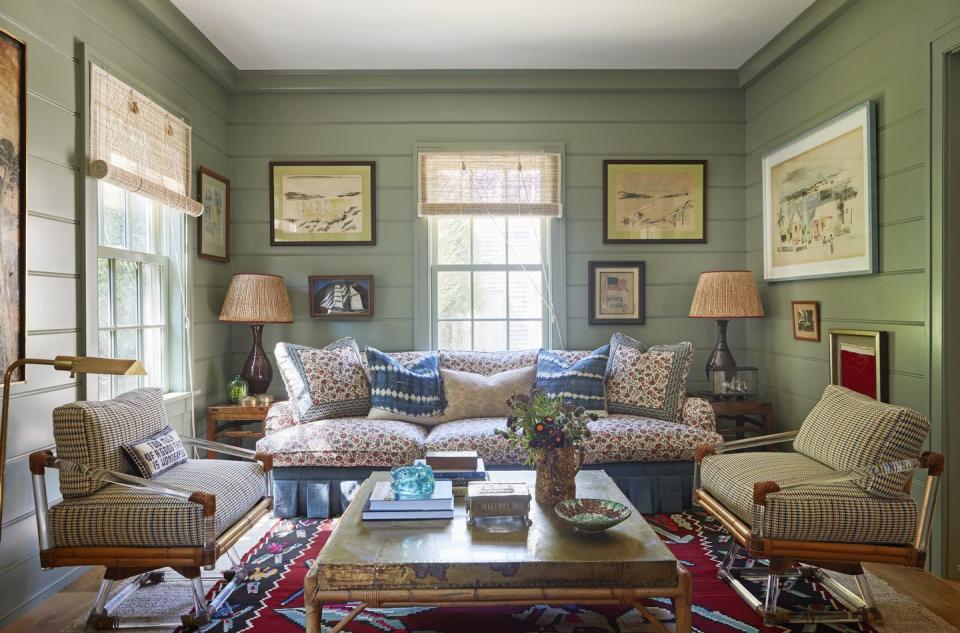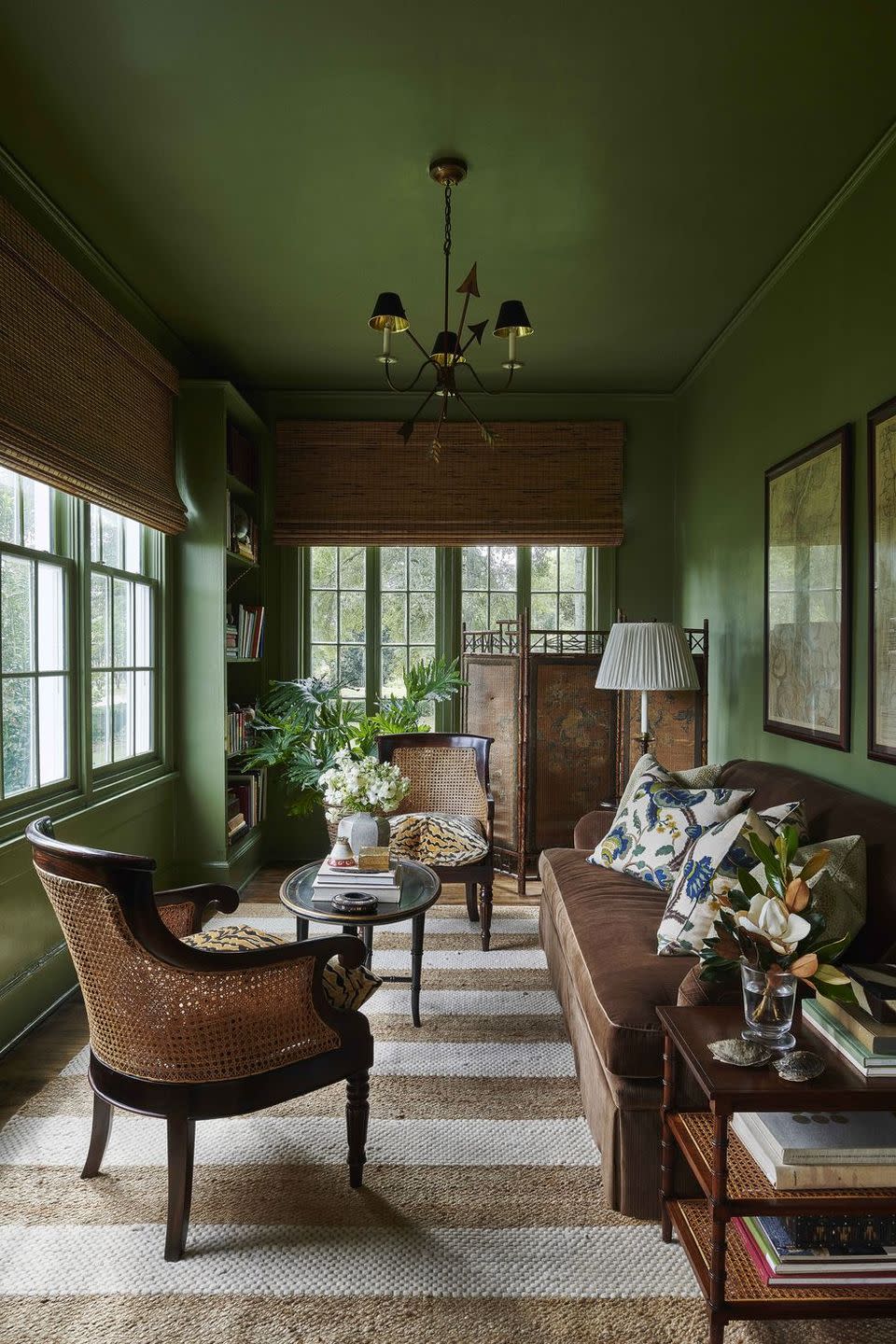How Your Home's Paint Colors Can Make You Happier, According to Experts

"Hearst Magazines and Yahoo may earn commission or revenue on some items through these links."
Color is at the heart of all Natalie Papier’s decisions. The Charlotte, North Carolina, designer has a reputation for “unapologetically out-of-the-box designs” that emerge from her use of colorful wallpaper, eclectic art, and funky textures. These bold, eclectic rooms make her clients—in a word—happy.
Most of the time when people don’t like a color, Papier believes it’s because they’re thinking of it in the context of an eight-crayon box from kindergarten. She encourages her clients to imagine a bigger crayon box. “When you start out with a few primary colors and you graduate to a box of 64, you realize there’s more than just purple. There’s wisteria and lavender and eggplant,” she says. “You get a better understanding of the colors you’re drawn to.”
For Papier, that color is yellow. “The color of sunshine and hope. Marigolds that feel warm and buttery. The color of cheer and a pop of happy,” she describes. “From bright to light, that golden glow will forever be my mood-lifting color.”
How Paint Color Can Impact Our Mood

Karen Haller, a global expert in applied color and design psychology and author of The Little Book of Colour, has dedicated her career to helping people connect with their inner happiness by harnessing the power of color.
When she teaches courses to design professionals, they’re often surprised that color can influence how we think, feel, and behave. “And this can happen in an instant,” Haller says. “Color isn’t just something that is aesthetically pleasing. It elicits an emotional response. Whether we realize it or not, we are having subconscious reactions to color all the time.”
Why that happens, exactly, takes us back to science class. Light enters our eyes, strikes a cone, and initiates an electrical message that’s conveyed to the brain—and eventually to the hypothalamus, which governs everything from our appetite to our sleep and body temperature. “Each color has its own wavelength and frequency, so the different colors we see are different wavelengths of light coming at different rates,” Haller explains. “We then take this in through our eyes.”
In other words, color isn’t just a visual stimulus. “Each wavelength with its different frequency elicits a different response within us,” Haller says.
According to the theory of color psychology, yellow represents happiness and orange represents joy.
But the way Haller sees it, our cultural beliefs and own personal associations with color play an equally important role in which colors make us happy. “While yellow might be the color of happiness in color psychology theory, if you’ve had a negative experience around yellow, then it’s likely you won’t feel happiness when you see yellow.”
Her recommendation? Forget what theory says, and go with the colors that make you happy. “We have to get away from this idea that there is one-size-fits-all,” Haller says. “When we surround ourselves with colors that make us feel good about ourselves, it can only help to positively support our well-being.”
Discover Your "Happy Colors"

When it comes to color, Papier likes to foster curiosity.
Sometimes people can tell you exactly which colors bring them joy. Other times, they haven’t given it much thought. If Papier talks to clients about color and they feel intimidated, she asks them to show her their favorite outfit. “They might feel great in this color pink because it makes them feel vibrant and expressive—but they’re afraid to use it in their home.”
For color beginners, Papier suggests swapping white, beige, or gray for a muted version of a color they love. “Any muted color can actually work as a neutral and will give your room a totally different feel. If people feel nervous, I would steer them toward a more muted gray-blue, and then use a bolder blue on a pillow,” she suggests. “You’re still evoking color senses, but not overwhelming what you think of as a calming space.”
When in Doubt, Lean Towards Colors in Nature

Papier has found that people are naturally drawn to greens and blues. “Those colors remind people of being in nature,” she says.
According to Haller, that’s because outside makes us feel grounded, present, and more connected to a natural way of living. “Our visual system is wired to recognize the colors and patterns of nature,” she says. “When we see them, it triggers positive responses in our sensory system.”
That leads to multiple benefits, including “encouraging the body’s natural healing to restore a sense of balance,” Haller says.
Create a Sense of Balance

Papier doesn’t shy away from the idea of rich hues, but she’s careful to balance them with other colors throughout the house. “A really beautiful, saturated blue can take your room from stark to cozy, but it needs to speak to the colors and textures in other rooms.”
In her own home, Papier painted the living room walls white and the ceiling Espalier Green, a saturated grassy green. “In the adjacent kitchen, I used a neutral pink—a nude blush color—to complement the green. I didn’t want them to compete in levels of saturation.”
Even though Papier’s cabinets are technically pink, they read as more of a neutral. “Nobody walks into my kitchen and says, ‘wow, you have a pink kitchen.’ It barely even registers; instead, it feels like hints of color that give you different feelings throughout the day.”
In conclusion, you don’t have to paint your walls bright pink to be surrounded by colors that make you happy, Papier says. “Color is a great way to bring joy into your home. Start small, and see how it feels.”
You Might Also Like

